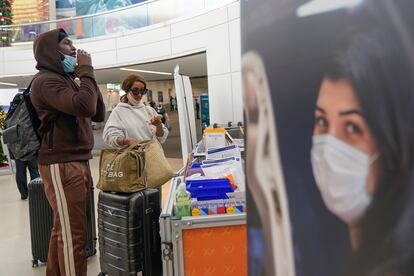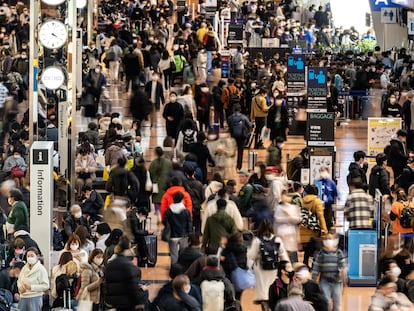A new, more contagious Covid subvariant is spreading in the US
XBB and XBB1.5 now account for more than 44% of all coronavirus cases in the United States, although no data indicates that these infections are more serious


A new descendant of the Omicron variant of Covid-19 – XBB1.5 – is spreading at full speed in some areas of the United States. With high contagion capacity, it already accounts for a high percentage of cases in a country where infections are on the rise, fueled by a season of travel and indoor gatherings.
According to data from the Centers for Disease Control and Prevention (CDC), the XBB and XBB1.5 subvariants accounted for 44.1% of all Covid cases in the US during the week of December 31. A week earlier, that proportion was far lower, at 25.9%. And, in the week of December 15, it was just over 10%.
Maria Van Kerkhove – an epidemiologist and technical manager of the response against Covid at the World Health Organization (WHO) – has expressed her concern from Geneva. “[They’re] the most transmissible subvariants that have been detected so far,” she pointed out.
While there is no indication that the subvariants are more deadly or cause more serious infections, the speed with which they are spreading is worrying scientists. “The more this virus circulates, the more opportunities it has to mutate.”
Concerns have been exacerbated by the fact that China – the world’s most populous country, already in the grip of a new Covid wave – is preparing to open its borders this weekend for the first time in nearly three years. The WHO and several governments have criticized Beijing for its lack of transparency regarding infection data. Meanwhile, XBB1.5 – a mutation that has the ability to attach itself to human cells more easily – has already been detected in 29 countries.
In the United States, the combination of the new subvariant and the holiday season – which began in late-November with Thanksgiving – has led to an increase in the number of Covid cases and hospitalizations. The average daily number of cases recorded between December 29 and January 3 is 6,519; the previous week, the total was 5,613.
The new mutation was first detected in October, in New York and Connecticut. Currently, according to CDC data, XBB and XBB1.5 infections already account for 75% of cases in the New York-area, while they account for 86.2% of overall cases in New England.
So far, there is no data to suggest that infections by this subvariant are more serious, even if they are more contagious. Experts have also stressed that existing Covid vaccines and treatments appear effective against the subvariants. Given the population now has a much higher level of immunity against Covid, it is not expected that the situation will reach the peak pandemic levels of the past three years.
In New York City – one of the focus points of the new subvariants – hospitalizations have increased. According to the city’s Department of Health, the current rate is 22.26 per 100,000 residents, the highest level since February 2022. But it is difficult to attribute the rise to XBB1.5, as respiratory diseases tend to proliferate in the winter. Most of those admitted to hospital with Covid across the state of New York – 54.8% – were not hospitalized because of the subvariants. Symptoms were weak enough that the disease could only be detected via test.
“We expect new waves of infection in the world, but that doesn’t have to translate into new waves of death, because our measures against the virus continue to work,” Van Kerkhove stressed at her press conference.
A WHO technical group has been established to study the evolution of the virus and assess the risk that the new subvariants represent. The group is closely monitoring any possible changes regarding the severity of XBB and XBB1.5, using laboratory studies and data obtained among various populations. According to Van Kerkhove, a report is expected to be published in the coming days.
The CDC has reiterated its appeals to the general public to go get booster doses. Although 70% of Americans are vaccinated with two doses, only 15.4% of those over the age of five have received booster shots. Only among those over 65 years of age – the population at greatest risk of Covid– is the Covid booster rate higher, at 38.1%.
The US government aspires to make Covid vaccines an annual campaign, as is done with flu shots. US President Joe Biden discussed this in October of last year: “For most Americans, one dose against Covid a year will be all they need. And if they receive it, they will be protected. And if you don’t [get boosted], you’re putting yourself and others at unnecessary risk.”
For now, Washington has renewed the requirement that foreign visitors to the United States present vaccination certificates. The Biden administration is also requiring that travelers coming from China present negative Covid tests, carried out no more than 48 hours before the time of departure.
Sign up for our weekly newsletter to get more English-language news coverage from EL PAÍS USA Edition
Tu suscripción se está usando en otro dispositivo
¿Quieres añadir otro usuario a tu suscripción?
Si continúas leyendo en este dispositivo, no se podrá leer en el otro.
FlechaTu suscripción se está usando en otro dispositivo y solo puedes acceder a EL PAÍS desde un dispositivo a la vez.
Si quieres compartir tu cuenta, cambia tu suscripción a la modalidad Premium, así podrás añadir otro usuario. Cada uno accederá con su propia cuenta de email, lo que os permitirá personalizar vuestra experiencia en EL PAÍS.
¿Tienes una suscripción de empresa? Accede aquí para contratar más cuentas.
En el caso de no saber quién está usando tu cuenta, te recomendamos cambiar tu contraseña aquí.
Si decides continuar compartiendo tu cuenta, este mensaje se mostrará en tu dispositivo y en el de la otra persona que está usando tu cuenta de forma indefinida, afectando a tu experiencia de lectura. Puedes consultar aquí los términos y condiciones de la suscripción digital.
More information
Archived In
Últimas noticias
Most viewed
- Sinaloa Cartel war is taking its toll on Los Chapitos
- Oona Chaplin: ‘I told James Cameron that I was living in a treehouse and starting a permaculture project with a friend’
- Reinhard Genzel, Nobel laureate in physics: ‘One-minute videos will never give you the truth’
- Why the price of coffee has skyrocketed: from Brazilian plantations to specialty coffee houses
- Silver prices are going crazy: This is what’s fueling the rally










































